|
March 24, 2022
Dear Neighbors and Friends,
I hope that you and your loved ones are doing well, staying healthy, enjoying the spring blossoms, and looking out for your neighbors and friends during this past week.
The bulk of tonight’s focus is on legislative matters, but I couldn’t resist including some COVID updates. As you’ll see, our COVID numbers continue to drop steadily, particularly hospitalizations, which is great news. Needless to say, though, we’re still feeling the effects of the pandemic: even though new the number of Omicron infections has plummeted, Oregonians are continuing to die from the effects of Omicron infections that began in January and February. Just this week Oregon hit another sad milestone: 7,000 Oregonians have now lost their lives due to COVID. Since death is a lagging indicator, we’ll continue to see many deaths reported each week for a while.
I had hoped to be able to share the latest OHSU forecast with you, but it looks as if it won’t be out till tomorrow. I’m curious to see Dr. Graven’s latest thoughts. As you’ll see from the graph in this newsletter, the new Omicron BA2 subvariant is making its way into Oregon. It is apparently more contagious than the original Omicron, but not more virulent, and the existing vaccines appear to be effective against severe illness from it. That’s great news. However, we are seeing an uptick in cases in the UK as a result of this subvariant and the relaxation of COVID requirements. So far, though, it doesn’t seem to be something to worry about. We’ll have a better idea of that over the next couple of weeks. I’ll let you know if we’re seeing an increase in the number of hospitalizations.
You’ll notice that I have reduced the amount of COVID information I’m sharing with you now, focusing on the most essential. Let me know if there’s anything that you wish were still there.
Tonight’s newsletter begins the in-depth review of the 2022 bills that I was particularly involved with. Not surprisingly, given my responsibilities chairing Senate Education, I’m starting with the Education-related bills. I’ll follow up with the remainder of the Education bills next week, then move on to Environment, Energy, and Natural Resources, and then on to other issue areas.
Now that we’re in the “interim” between sessions, most of my time will be spent following up on those bills that passed, restarting the effort to pass those priorities that didn’t, and starting work on new priorities. It’s a time for meetings (yes, they’re starting to be in-person once again), site-visits, conferences, task forces, and work groups. Next week we'll have the first site visits for the Task Force on Underrepresented Students in Higher Education. We’ll be meeting with students and staff at Portland-area colleges and universities for two full days, hearing about the challenges faced by first-generation students and exploring ways to make education more affordable and increase their success. We’ll be traveling all over the state between now and the end of July to do the same, following the model that eventually led to the successful Student Success Act for Pre-K, Elementary, and Secondary students. I’ll keep you abreast of what we’re hearing, learning, and considering in advance of the session.
I am happy to report that it’s not just meetings, work groups, task forces, and fundraising for me, though. As you’ll see from the photos below, I’m happy to report that I was able to finish the 15K Portland Shamrock Run last week with my daughter and emerge smiling! And Kiki and I were able to get away to Astoria for a few days of hiking, walking, natural beauty, good food, and lots of time in brewpubs.
I hope that you too are able to find some time away from the news, politics, and social media, however you can. Until the next newsletter, please stay healthy and safe. And let me know if you have any questions or thoughts about anything in tonight’s newsletter.
 
Coming Up: April Constituent Coffee!!!
Saturday, April 2, is the first Saturday of the month, and that means it’s time for our regular constituent coffee from 9 to10:30. It will be virtual again, though I’m hoping that in May we’ll be able to do it in person. (And thereafter a mix of in-person and virtual.)
This will be a chance for us to debrief further on the 2022 session, let you know more about the interim work that’s going on, and get your thoughts for future action.
Hope to see you there! I’ll have the registration link in next week’s newsletter.
If Eligible, How Do You Get Your One-Time $600 Assistance Payment?
One of our budget decisions at the end of the 2022 session was to send one-time federal dollars to low-income workers in the form of one-time $600 payments. This came as a result of HB 4157, which passed the House 42-16 and the Senate 23-2.
It was the result of an effort led by Representative Andrea Valderrama to provide much-needed compensation for essential workers who had to keep working in close contact with others during the pandemic. It was also designed to help low-income households cope with the current rising costs due to inflation.
The effort faced some initial challenges over the process of determining and identifying those who would qualify. The Director of the Oregon Department of Revenue recommended that we tie the payments to those low-income households who already qualify for the federal Earned Income Tax Credit (EITC): this would make the payments easier to administer quickly. This was the methodology that was ultimately chosen.
Those who have already filed their 2020 taxes and will be receiving the EITC will receive their payment automatically—they don’t need to do anything. The same goes for those who haven’t filed yet.
Those who have already filed but didn’t request the EITC despite qualifying for it can file an amended return to get their payment. PLUS, it will get them the EITC that they SHOULD be receiving.
We know that there are many households in this state and others that are not really aware of this benefit, so are not taking advantage of it. We’re hoping that the availability of these $600 payments will help low-income families become aware of the benefit and will start to access it. Please, if you know of any families that may qualify (based on income and number of people in the household—e.g., $53,000 for a family of four), please let them know about this.
Rep Valderrama and her staff have created some very helpful graphics about the program for you to check out and share. They include lots of info about the program, including the qualifying thresholds for EITC. MANY THANKS to Rep Valderrama and her staff for all their work on this benefit.
And finally, here’s information about the program from the Oregon Department of Revenue.
Changes at the Capitol
I’ve talked before about the changes that we’re seeing in the legislative body, with a number of legislators—including long-term leaders in both chambers—retiring, running for other offices, leaving for other opportunities, or simply deciding that they cannot afford to support their families with the salary provided for what has really become a full-time job (if you do it right).
Well, it’s not just the faces that are changing—it’s the Capitol building itself that will see changes over the next few years. As anyone who has visited the building during the last few years knows well, we are in the middle of serious modification of the building, mainly designed to make it more resilient in the face of a serious earthquake. Last year work was done on the wings of the building, the newer part. Starting this spring and summer, the work will begin on the older (1938) parts, thanks to funding just approved in the last session.
The next phase of the construction project will both address seismic risks and provide a number of updates and improvements to the older parts of the building. You can get a sense of this phase of the project (known as “CAMS III”) in this PowerPoint Presentation.
From my own selfish perspective, this news is bad. As you’ll see if you scroll down to the final page of the presentation, you’ll see that a lot of the building will be off limits for the next couple of years (i.e., for the remainder of my tenure as a senator). That includes the Senate chamber itself. We’ll still have access to it for the next round of Legislative Days (first week of June), when we go to the floor for the sole purpose of voting to confirm executive appointments.
And that will be it until the 2025 long session. In other words, I’ve made my last floor speech on the floor of the Senate. Starting with September Legislative Days, we’ll be crammed into one of the small hearing rooms to do our business as a body.
We just found that out last Friday, and the reality of it is sinking in. Sigh.
On the positive side, once all the work is completed in time for the 2025 long session, it will be a safer, more accommodating building. On the downside, I won’t be around to appreciate it. But back to the upside, by then I’ll be happily retired, so I cannot complain!
LOOKING BACK AT THE 2022 SESSION: EDUCATION (Part 1)
SB 1521: Superintendents Protections
Passed 16-7 Senate, 31-25 House, 16-8 Senate Concurrence
Interestingly, SB 1521 turned out to be one of the most partisan of all the bills I worked closely on this session.
It was the bill designed to bring more stability for district staff caught in the middle of political crossfires (think COVID response and equity initiatives). It prohibits school district boards from directing superintendents to violate state and federal laws (or directives that come with the force of law) that they disagree with, and it prohibits them from firing superintendents if they refuse to do so.
It also provides superintendents with one year of notice if the Board chooses to terminate their contract without good cause (i.e., without having to show that the superintendent is failing in some way). This was a particular request from women superintendents and superintendents of color, who feel particularly exposed to decisions that have nothing to do with their performance.
As I’m sure you know, the need for this legislation was provoked by abrupt, highly-disruptive terminations that occurred last summer in several districts. These firings led to a rash of requests for the Legislature to take action to protect superintendents and the staff that they supervise from political interventions. I decided to turn to the Coalition of School Administrators (which represents superintendents and other administrators) and the Oregon School Boards Association (which represents school boards) and see if they could agree on a compromise that would work for staff and boards alike. They did, and that compromise became SB 1521.
Nevertheless, the bill was very controversial, with opponents calling it an infringement of the principle of local control. As I pointed out in my floor speech, local control is an important principle, but it is not without limits. Local school board members are certainly free to disagree with state and federal law around controversial issues and to express that disagreement, but they don’t have the right to order others to violate the law.
You can read my floor speech here.
The bill included an “emergency clause,” so it went into effect when the Governor signed it on March 17.
SB 1522: Omnibus Senate Education Bill
Passed 22-4 Senate, 38-20 House
This bill is a collection of a number of technical fixes and needed improvements to bills that passed last year, along with some initiatives that failed to make it through Ways and Means last year. Here are a few of its more noteworthy elements:
- Improvements to last year’s Health Care for Part-Time Higher Ed Faculty;
- Improvements to the Oregon Promise, focusing more on low-income students;
- Pilot programs at Coffee Creek Correctional Facility (our women’s prison) and Snake River Correctional Institution in Ontario, allowing them access to internet prison education programming;
- Expanding access to in-state university tuition for newcomers from Afghanistan (and, sadly, now Ukraine).
The omnibus bill addresses 14 different problems. I provide a brief explanation of each in my floor speech on SB 1522.
HB 4030: Addressing Educator Workforce Shortages
Passed the House 48-11, 24-2 in the Senate
As I’ve mentioned before, one of the things that our COVID experience brought to a head was the shortages that are prevalent among our education workforce. School districts have been finding it increasingly difficult over the last decade to recruit and retain teachers and other school personnel.
This problem is not unique to Oregon. It’s a challenge that districts all over the country have been facing. If they didn’t realize it was happening before COVID, they do now. Legislators everywhere are trying to find solutions.
This is a challenge that is partly due to demographics (triggered by retirements among massive number of baby boomers), partly due to the difficulty states are having with providing staff with competitive wages and benefits, partly due to the changing nature of student needs and of the job itself.
This is a challenge that will require extensive long-term action, but we were able to put together a package of proposals to make a difference during this school year and next. I say “we” because this has been a bipartisan, bicameral effort between members the Senate and House Education Committees.
The $100 million package includes recruitment/retention grants for high-need teachers and classified employees, support for substitute teachers, removing bureaucratic barriers to the licensure process, improving reciprocity between states, development of a common application and background check process, among others.
As you can see, the package went on to receive strong support from both chambers. You can see the details of what’s in the package and the need in my floor carry.
Work on the next steps of solving the problem is among my top priorities for the interim. I’ve reconvened the large work group that gave us the initial recommendations that led to HB 4030, and we’ll be having our first meeting next Tuesday. Most of the initial work will be done through three subgroups: Compensation, Retention/Working Conditions, and Recruitment/Educator Pipeline. They’ll be looking at removing barriers and incentivizing entry into these professions, particularly those areas that are hardest to fill. They’ll also be looking at what other states are doing or considering to overcome these challenges, and identifying best practices.
I’ll provide you with regular updates. As always, I’d love your thoughts and recommendations.
Summer Learning
I’m pleased to report that the big final budget bill included $150 million for a package of summer learning programs for children and youth. You may remember that this was something we started talking about at the beginning of 2021 as a way of coping with what was already shaping up to be a year of remote learning for most students. I convened a group to start the planning process, and it eventually became a priority for Speaker Kotek and President Courtney. The result was a $200 million appropriation and a series of extremely successful and enriching programs for kids of all ages all over the state last summer.
Here’s the description of the allocation from the Budget Report for HB 5202:
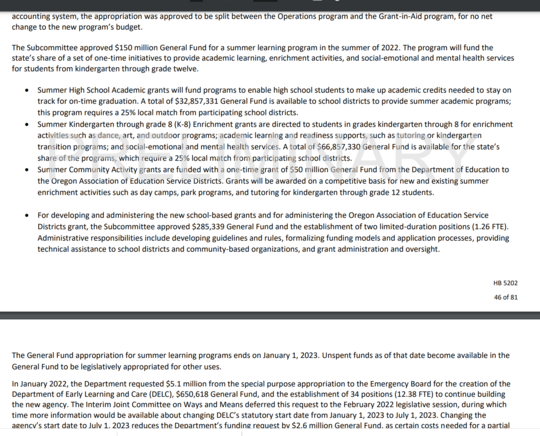 In its first year last summer, $110 million of that original $200 million was ultimately spent on those programs, which were a combination of camps, classes, tutoring, and activities sponsored both by districts and by nonprofits. More of that could have been spent, but the money came late, and there were COVID challenges, along with workforce challenges. Having had that experience, I believe that we can do better this summer. To help with that, I brought different providers together a couple of weeks ago to make sure that the pieces were in place for improvements and further outreach this summer. We’ll meet again next week to further the coordination.
Our goal is to make these programs a combination of learning and fun, something that kids can really look forward to. Ideally, even for students who need to make up for lost credits, the classwork will be nested within programs that will be relevant and fun and enhance a love of learning.
The priority for now will be to create as many options as possible for the kids most negatively affected by the COVID experience: for example, kids with disabilities and kids from low-income families that can’t afford to pay for tutoring or summer camps. Unfortunately, summer is traditionally a time when kids from more affluent families are exposed to a variety of learning opportunities, while those from poor families fall further behind. We need to change that.
Finally, our hope is that the $150 million will not be enough because there is so much interest and demand. And then one of the priorities for the 2023 session will be to find the funding to keep this priority going.
Please let me know if you have suggestions for this work going forward.
You can read about the plan for summer programs in this press release. And here’s a press release about the entire Education package.

ON THE COVID FRONT
Additional COVID Updates and Links
- The UK is experiencing a surge in new hospitalizations. Does that mean it's time for us to reimpose COVID guidelines here in the U.S.?
- And what does the increase in COVID cases in Western Europe mean for us in the U.S.?
- If there is another surge on the way with the new subvariant, are we ready for it?
- Most parents in Oregon say educators have been keeping their kids safe during the COVID-19 pandemic. Here are the results of a recent survey.
- In an odd turn of events, many hospitals and nursing homes are asking visitors to replace their N95s with surgical masks. Here's why.
- As the CDC is receiving fewer test results now, wastewater analysis may be increasingly important--and it's showing an uptick.
- Not all states are reporting wasterwater data. More on that here. (Incidentally, for some reason, the CDC is among those not reporting information from Oregon. I’ve asked OHA to look into why that is. Oregon is among the states continuing to analyze wastewater, and you can follow those results here.)
- We’re now starting to see more calls for a second booster, at least for older Americans. Pfizer has applied for authorization. Meanwhile, Moderna has applied for authorization for boosters for all.
- And here’s a more detailed story from The Atlantic on whether or not it's time for a second booster.
- And perspective from MedPageToday about what "waning immunity" really means.
- And here’s late-breaking news on an Israeli study showing only marginal benefits from a fourth dose.
- In an interesting turn of events, we’re learning that the single-dose Johnson & Johnson vaccine has actually done well in preventing serious COVID, ultimately just as well as the two-dose mRNA vaccines.
- In order prevent future health disruptions, it's time to double down on infection prevention, says the President of the Society for Healthcare Epidemiology of America and Chief Infection Prevention Officer at Beth Israel Lahey Health.
- If you’re an Oregon state, local, or university employee and haven’t yet received a booster, you can earn an extra $100 in your pay if you do so by the end of April.
- Many low-income countries still have low vaccination rates. Should they be rethinking the 70% vaccination goal, or focusing differently?
- What do we do about masking for children still too young to be vaccinated.
- As the pandemic enters this new phase, Oregon will maintain its vaccination and testing focus on the low-income households that have been hardest hit.
- While many are embracing the long-awaited lifting of the mask requirements, it is presenting challenges for the immunocompromised.
- The most vigilant Americans are having the hardest time adjusting to the relaxation of COVID requirements.
- One year after passage, how have the ARPA stimulus dollars been spent?
- One of the lessons learned during COVID was that “ECMO Therapy” saved many lives—when it could be deployed early in the illness.
-
An NIH study, looking back at the Delta surge, found that schools with mandatory masking had approximately 72% fewer cases of in-school transmission of COVID when compared to schools with optional or partial masking policies.
- And another piece of good news from another lookback study: transmission from mother to baby has been very rare.
- On the other hand, there is further evidence of the serious negative effects that COVID can have on the pregnant woman herself.
- And one from the CDC shows enormous differences between the vaccinated and the unvaccinated in preventing serious illness from Omicron.
- In a less-positive outcome, another lookback shows that hospitalizations of black Americans reached a new pandemic high during Omicron.
- Our state epidemiologist, Dr. Dean Sidelinger, explains why it's now safe to end the masking requirements.
- The New York Times’ Zeynep Tufekci takes a look back at the heavy toll of the pandemic and speculates on how millions of lives might have been saved.
- Problems with cognition and memory appear to be characteristic elements of long COVID.
- What's up with masking on planes?
- Moderna reports significant success of its vaccine in trials with kids under 5.
-
One of the casualties of Congress’s inability (so far) to provide additional funding for COVID response funding for a fourth dose if it is needed.
OHA Weekly Report: Another Big Drop in New Oregon Cases, Hospitalizations, and Deaths
The COVID-19 Weekly Data Report, released on Wednesday, showed declines in weekly cases, COVID-19-related hospitalizations and deaths.
- The Oregon Health Authority (OHA) reported 1,769 new cases of COVID-19 during the week of Monday, March 14, through Sunday, March 20 – a 19% decline from the previous week’s 2,185.
- There were 156 COVID-19-related hospitalizations, a 31% decrease over the previous week’s 225, and the lowest weekly total since late July.
- There were 90 COVID-19-related deaths, down from 142 the previous week.
- Reported COVID-19 test results dropped by 5.7%. There were 89,917 tests administered.
- Test positivity dropped to 2.5%, the lowest since mid-July. Weekly tests have fallen 69% since the Omicron peak in mid-January. The percent positivity rate has fallen from 24.5% to 2.5% over the same period.
Today’s COVID-19 Weekly Outbreak Report shows 98 total active outbreaks in care facilities, senior living communities and congregate living settings, down from 143 last week, and 197 the week before that. OHA reported twenty COVID deaths for residents of congregate care.
The Outbreak Report also includes the latest data on COVID in workplaces, childcare centers, and public and private K-12 schools.
Weekly County Report: Continuing Big Declines Around the State
The latest OHA county report, showing increases/decreases in COVID spread for each county and for the state as a whole, was released on Monday. It shows case counts and rates for the last four weeks, including data up to March 20.
The Omicron transmission numbers reported this week have now further dropped to Low levels for the state as a whole.
The statewide infection rate has gone from 59.2 per 100K in the last report to 46.6 per 100K in this one; even more heartening is to see the test positivity rate continuing to go down, from 3.3% last week to 2.5% this week.
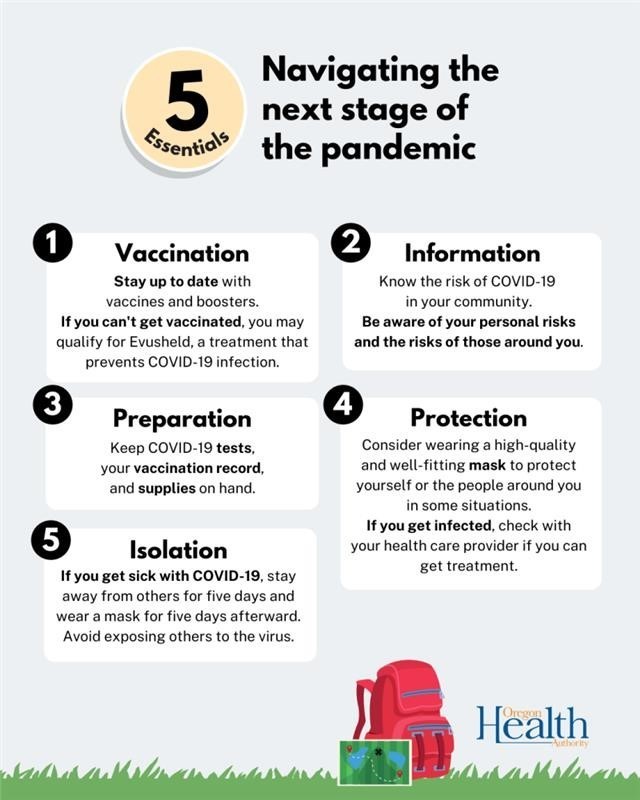 
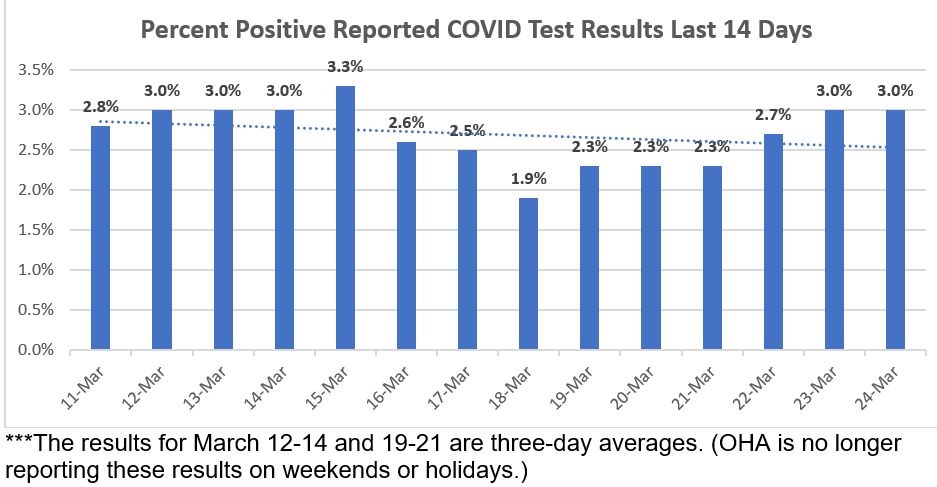
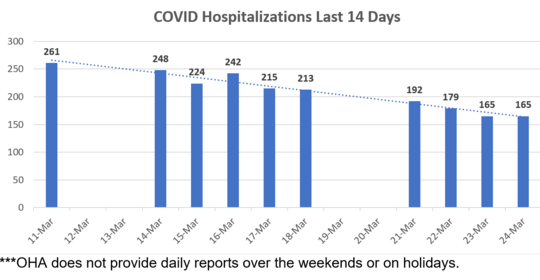
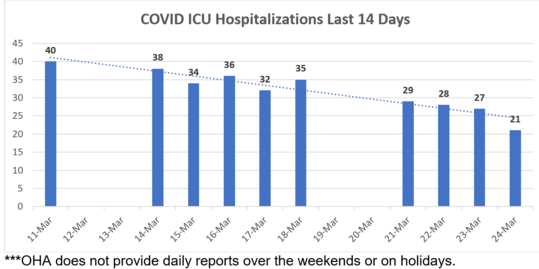
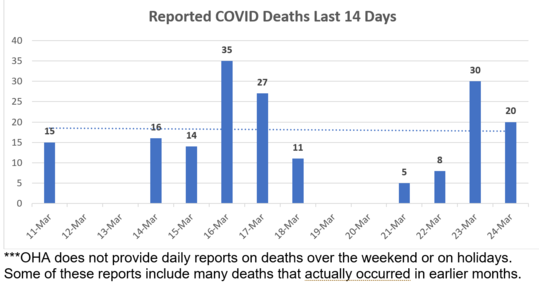
Here again are some COVID resources that you will find useful
If the above links are not providing you with answers to your questions or directing you to the help that you need, please consider me and my office to be a resource. We’ll do our best to assist you or steer you in the right direction.
Want to See Past Newsletters?
If there was COVID-related information in a past newsletter that you want to go back to, but find you’ve deleted it, you can always go to my legislative website (senatordembrow.com), click on “News and Information,” and you’ll find them all there. Also, if someone forwarded you this newsletter and you’d like to get it directly, you can sign up for it there.
Best,
 Senator Michael Dembrow
District 23
email: Sen.MichaelDembrow@oregonlegislature.gov
web: www.senatordembrow.com
phone: 503-986-1723
mail: 900 Court St NE, S-407, Salem, OR, 97301
|